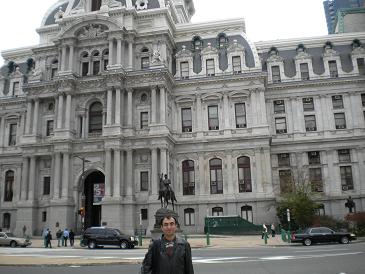|
 Profesor Dr. Vahit Bıçak visited the Philadelphia's City Hall, which is directly at the heart of Philadelphia, on Center Square, a National Historic Landmark rises 510 feet into the air. Profesor Dr. Vahit Bıçak visited the Philadelphia's City Hall, which is directly at the heart of Philadelphia, on Center Square, a National Historic Landmark rises 510 feet into the air.
(5 December 2009) Profesor Dr. Vahit Bıçak, a visiting scholor of the City University of New York, visited the Philadelphia's City Hall, which is directly at the heart of Philadelphia, on Center Square, a National Historic Landmark rises 510 feet into the air. The huge granite mass of City Hall, throughout its 100+ year history, has indeed been a building of "publick concerns". An elaborate temple of local politics, City Hall is one of the nation's finest examples of French Second -Empire Architectural style. At 167 m (548 ft), including the statue, it is the world's tallest masonry building: the weight of the building is borne by granite and brick walls up to 22 feet (6.7 m) thick, rather than steel; the principal exterior materials are limestone, granite, and marble. It was the tallest habitable building (although surpassed by monuments) in the world from 1901 to 1908 and the tallest in Pennsylvania until 1932 when surpassed by the Gulf Tower. It remained the tallest building in Philadelphia until the construction of One Liberty Place (1984-1987) broke the informal "gentlemen's agreement" that limited the height of tall buildings in the city. It remains the tallest masonry building in the world.
The building was designed by Scottish-born architect John McArthur, Jr., in the Second Empire style, and was constructed from 1871 until 1901 at a cost of $24 million. Originally designed to be the world's tallest building, by the time it was completed it had already been surpassed by the Washington Monument and the Eiffel Tower, though it was indeed the world's tallest habitable building at the time of opening. It also was the first modern building (excluding the Eiffel Tower) to hold the record for world's tallest and also was the first secular building to hold this honor: all previous holders of the position of world's tallest were religious structures, whether European cathedrals or, for the previous 3,800 years, the Great Pyramid of Giza.
With close to 700 rooms, City Hall is the largest municipal building in the United States and one of the largest in the World. The building houses three branches of government, the Executive (Mayor's Office), the Legislative (City Council), and the Judicial Branch's Civil Courts (Court of Common Pleas). |



 Profesor Dr. Vahit Bıçak visited the Philadelphia's City Hall, which is directly at the heart of Philadelphia, on Center Square, a National Historic Landmark rises 510 feet into the air.
Profesor Dr. Vahit Bıçak visited the Philadelphia's City Hall, which is directly at the heart of Philadelphia, on Center Square, a National Historic Landmark rises 510 feet into the air.